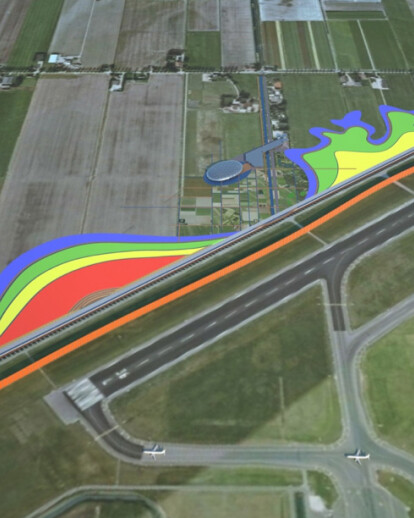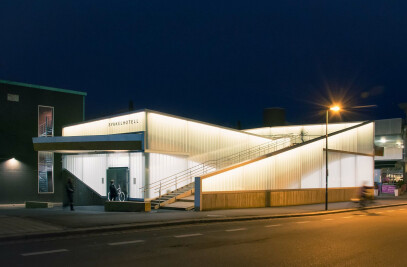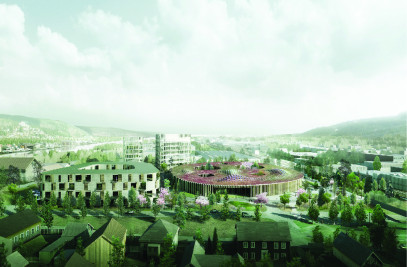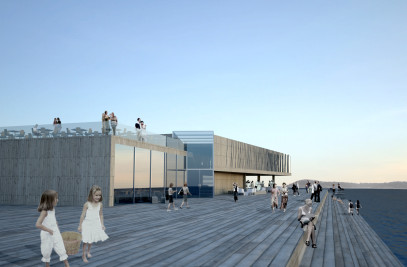The concept The siteplan depicts the energy and sound generated upon takeoff as a series of contours and boundaries in the landscape, a site specific study of sound and wind, two of the basic forces that define the need for the sound barrier. Dynamic wind simulation and sound simulation of the site and many different wall configurations were carried out in an iterative form generation process. The results of the tests were studied to give inspiration to the forms visible in the siteplan.
The vision The vision was to create a noise reduction facility that not only acts as a sound barrier but also a facility that reflects Amsterdam Airport Schiphol’s (AAS) standing on the environment. Schiphol Sound and Environmental Centre (SSEC) will be a centre to showcase AAS’s environmental efforts as well a centre to explore environmental technologies, where the various facilities would be used to develop and educate, serving both the general public as well as sustainable industry. The sound barrier wall proposed is a dynamic sculpture that is an innovative proposal on many levels. It is 2km long, 18m high, with a unique rolling counterweight mechanism that allows it to be lifted into place in under 2 minutes and lowered in only 1 minute would be an amazing sight and feat of engineering. In addition to the wall itself, the entire park would be an innovative example of how to use sustainable technology to clean the environment of airport related wastes, create carbon neutral energy via biomass, and turn organic airport waste into energy. The selfsustained environmental and educational facility in The Hub would be a national and international attraction which would make AAS a visible world leader in green technology. The project could be a beacon for the use of sustainable building materials, phytoremediation, and the generation of green energy. Like the Eden Project in Cornwall, United Kingdom, this center has the potential to be an attraction in itself.
Overall layout The overall form of the SSEC in the landscape is important and should be experienced in several ways. This area will be visible from the air when aboard an aircraft taking off and landing, not only on runway 36L-18R, but also from adjacent runways. Further, it will also have to be readable at a pedestrian level as movement throughout the park will be encouraged. Several form generators have been attempted, and we have finally selected a form that is based on a sound diagram generated by takeoff from the runway. This diagram has been laid out on the site to create forms that offer an iconic and spectacular view from the air and ground. We have also emphasized a form that gives sensible areas and shapes to surfaces that will be used for specific purposes. From the air, the regularity of the adjacent landscape is evident, and shapes and scales similar to the park are not that far away. The park acts as an intermediary between the airport and the surrounding landscape. Directions throughout the existing landscape are used within the park to set up systems of movements as well as views. Further, some of the new landscape lines enter into small straight canals in the hub park, where visitor are allowed to experience the two landscape types at a detailed level and understand their integration through common processes like water management and biotope fusions. By creating contrast and an iconic form at the larger scale, the park also sustains and enhances the lines of the existing Polder landscape
The Wall The challenges posed by this competition require a large degree of innovation to effectively solve the technical problem of stopping the low frequency sound of airplane take-off while also following the strict rules and regulations of the airport. By our understanding, a static barrier could not meet the 7dB requirement of the brief, therefore a dynamic option which was both innovative and yet extremely reliable is necessary. The use of the rolling counterweight to lift and lower the wall ensures synchronized lifting of the system, introduces redundancy by having multiple motors connected to the same mechanism, and saves a massive amount of energy by balancing the lifting load. The system of folding panels that clamp to the diamond shaped columns use an innovative roller mechanism to ensure low friction to eliminate the problem of high winds stopping the wall from lowering. The panels themselves use an innovative and environmentally friendly thermoplastic composite. In Phase One of the competition the wall geometry was inspired by a traditional origami fold. Upon further investigations the origami fold proved overly complicated to translate into a wall of thick panels. There was concern that the complex hinging it would require made it more prone to failure or ‘locking’ in the up position, something which should be avoided at all costs. The geometry of that particular fold also had the disadvantage of expanding horizontally as well as vertically when extended. Although most of these problems could be solved by careful detailing the team decided to focus a system where reliability and robustness were extremely important. A number of different folding variations were explored and discarded, ultimately ending with a system of folding panels that stack into a compact horizontal base. Technically stunning, but based on simple principles of Newtonian physics, the project will both inspire and awe all who see or experience it. The project is equally iconic from 10,000m in the air, or from eye level in the park. Nowhere before has such a wall been proposed. The elements that create the wall itself are not based on a designers fancy, but follow strict and complicated guidelines. It is a solution born of the specific problem it was devised to solve, and thus completely unique.
Wind disturbance The effects of the retractable wall on the wind were reviewed using computational fluid dynamic (CFD) software simulations to ascertain the influence of the wall on the mean and fluctuating wind speeds on the runway. The CFD studies were performed using RWDI's proprietary software, Virtualwind, which uses large eddy simulation numerical techniques to calculate the flow characteristics in the vicinity of the wall and beyond, for various retracted heights. With the wall fully retracted to its 18m height, the simulations indicated reduced mean wind speeds and increased turbulence and vorticity within about 60m of the wall. Beyond this distance the winds in the wake region of the wall rapidly approached those of the oncoming flow with the wall collapsed, suggesting relatively low impact on the airport runway, satisfying the 7 knot criterion.

































